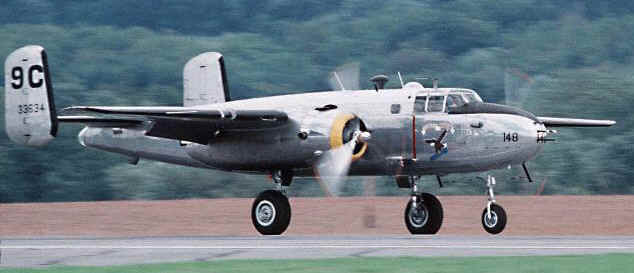 |
|
|||
|
|
||||
 |
|
B25 MITCHELL The North American B-25 Mitchell owed
its beginnings to the Army's quest for a medium bomber. The B-18
"Bolo" was designed and built by Douglas Aircraft in 1937 and
North American responded to this by designing and building the larger
and more powerful B-21 "Dragon" that same year. Both of these
aircraft were twin engine "tail dragger" types. Unsatisfied
with performance only marginally better than single engine aircraft, the
US Army Air Corps issued Proposal Circular #38-385 which was sent to all
major aircraft manufacturers in March 1938. It contained the
requirements for an "Aircraft - Bombardment Type - Medium".
This would fill a gap in the bombing aircraft types between the light
bomber and four engine heavy bomber. A total of 5 manufacturers
submitted designs (North American, Douglas, Martin, Stearman and Bell)
and all but one built prototypes. North American submitted their
"Design NA-40" to the USAAC and shortly afterward built the
NA-40B prototype. It was a sleek looking twin engine, twin tail machine
with tricycle landing gear, not unlike the B-25 and fairly bristling
with .30 Cal. (7.62 mm) machine guns. Unfortunately, while undergoing
simulated "engine out" tests, the pilot lost control and the
aircraft crashed. The pilot and crew escaped with minor injuries but the
NA-40B was destroyed by fire and North American was disqualified, though
the Army deemed the accident caused by pilot error and not by anything
inherent in the design of the NA-40B. That left only 3 prototypes
competing and shortly, one of these also crashed and burned (the Douglas
7B) and was disqualified, leaving less than half the original bidders
still competing. The USAAC ruled no contest, and though Glenn Martin
raised vigorous objections, new bids were ordered to be submitted in
April, 1939. |
| Specifications: | |
|---|---|
| North American B-25J "Mitchell" Medium Bomber | |
| Dimensions: | |
| Wing span: | Wing Span: 67 ft 7 in (20.59 m) |
| Length: | Length: 51 ft (15.55 m) |
| Height: | Height: 16 ft 4 in (4.98 m) |
| Wing Area: | 610 sq ft (56.67 mē) |
| Weights: | |
| Empty: | 19,530 lb (8,858 kg) |
| Gross: | 26,122 lb (11,848 kg) |
| Maximum T/O: | 35,000 lb. (15,876 kg) |
| Performance: | |
| Maximum Speed: | 285 mph (458 kph) at 15,000 ft (4,572 m) |
| Cruising Speed: | 230 mph (370 kph) |
| Service Ceiling: | 24,200 ft (7,376 m) |
| Normal Range: | 1,350 miles (2,172 km) with 3,000 lbs (1,360 kg) of bombs |
| Maximum Range: | 2,200 miles (3,540 km) with ferry tanks |
| Powerplant: | |
| Two R-2600-29 Wright
"Cyclone" 14 cylinder, air cooled radial engines developing 1,700 hp (1,268 kW) each for T/O |
|
| Armament: | |
| Eighteen .50 cal (12.7
mm) M-2 Colt-Browning machine guns. Up to 3,200 lbs (1,451 kg) of bombs |
|
